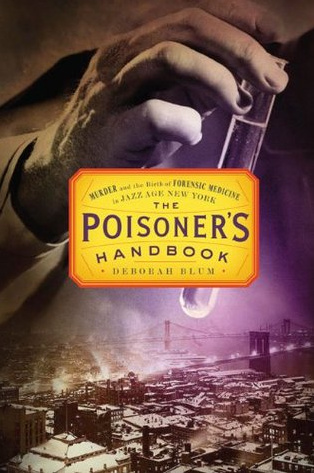

Deborah Blum · 319 pages
Rating: (22.2K votes)
“In a best-selling book, 100,000,000 Guinea Pigs (reprinted nine times by 1935), a pair of consumer-advocate authors complained that American citizens had become test animals for chemical industries that were indifferent to their customers' well-being. The government, they added bitterly, was complicit.”
― Deborah Blum, quote from The Poisoner's Handbook: Murder and the Birth of Forensic Medicine in Jazz Age New York
“There was the Bennett Cocktail (gin, lime juice, bitters), the Bee’s Knees (gin, honey, lemon juice), the Gin Fizz (gin, lemon juice, sugar, seltzer water), and the Southside (lemon juice, sugar syrup, mint leaves, gin, seltzer water).”
― Deborah Blum, quote from The Poisoner's Handbook: Murder and the Birth of Forensic Medicine in Jazz Age New York
“In his examination of the young dial painters, he’d discovered a fact that was impossible to dismiss. The women were exhaling radon gas.”
― Deborah Blum, quote from The Poisoner's Handbook: Murder and the Birth of Forensic Medicine in Jazz Age New York
“I see poisoners—so calculating, so cold-blooded—as most like the villains of our horror stories. They’re closer to that lurking monster in the closet than some drug-impaired crazy with a gun. I don’t mean to dismiss the latter—both can achieve the same awful results. But the scarier killer is the one who thoughtfully plans his murder ahead, tricks a friend, wife, lover into swallowing something that will dissolve tissue, blister skin, twist the muscles with convulsions, knows all that will happen and does it anyway.”
― Deborah Blum, quote from The Poisoner's Handbook: Murder and the Birth of Forensic Medicine in Jazz Age New York
“Standard Oil issued a cool response: “These men probably went insane because they worked too hard,” according to the building manager. And those who didn’t survive had merely worked themselves to death. Other than that, the company didn’t see a problem.”
― Deborah Blum, quote from The Poisoner's Handbook: Murder and the Birth of Forensic Medicine in Jazz Age New York

“From almost every standpoint ethyl alcohol must be regarded as the most important poison with which medical men and jurists have to deal,” Gettler wrote in a paper, listing a seemingly endless record of fatalities. “No other poison causes so many deaths or leads to or intensifies so many diseases, both physical and mental, as does [this] alcohol in the many forms in which it is taken.”
― Deborah Blum, quote from The Poisoner's Handbook: Murder and the Birth of Forensic Medicine in Jazz Age New York
“Nicotine had been isolated and synthesized in the nineteenth century. In pure form, it took an ounce at most to kill the average adult.”
― Deborah Blum, quote from The Poisoner's Handbook: Murder and the Birth of Forensic Medicine in Jazz Age New York
“a cloudy cocktail called Smoke, made by mixing water and fuel alcohol. Smoke joints were tucked into the back of paint stores, drugstores, and markets, among the dry goods and the stacked cans.”
― Deborah Blum, quote from The Poisoner's Handbook: Murder and the Birth of Forensic Medicine in Jazz Age New York
“Although traditional weapons killed far more people in the Great War, poison gas gave a new nightmare edge to the fighting.”
― Deborah Blum, quote from The Poisoner's Handbook: Murder and the Birth of Forensic Medicine in Jazz Age New York
“That same January the city government had released a report declaring that thanks to ill-informed, corrupt, and occasionally drunken coroners, murderers in New York were escaping justice in record numbers.”
― Deborah Blum, quote from The Poisoner's Handbook: Murder and the Birth of Forensic Medicine in Jazz Age New York

“The name explains the structure: carbon, hydrogen, and oxygen bond into a ring-shaped structure called a cresol (also found in creosote), and phosphorus hangs on to the ring like an exhausted swimmer gripping a life preserver.”
― Deborah Blum, quote from The Poisoner's Handbook: Murder and the Birth of Forensic Medicine in Jazz Age New York
“SCIENTISTS HAD KNOWN since the late nineteenth century that tobacco smoke contains carbon monoxide. Victorian scientists had even been able to calculate the amount of gas in the smoke: up to 4 percent in cigarette smoke, and in Gettler’s own choice of tobacco, the cigar, between 6 and 8 percent. Gettler’s latest work theorized that chain smokers might suffer from low-level carbon monoxide poisoning. He speculated in a 1933 report that “headaches experienced by heavy smokers are due in part to the inhalation of carbon monoxide.” But his real interest lay less in their symptoms than in how much of the poison had accumulated in their blood, and how that might affect his calculations on cause of death. He approached that problem in his usual, single-minded way. To get a better sense of carbon monoxide contamination from smoking tobacco, Gettler selected three groups of people to compare: persons confined to a state institution in the relatively clean air of the country; street cleaners who worked in a daily, dusty cloud of car exhaust; and heavy smokers. As expected, carboxyhemoglobin blood levels for country dwellers averaged less than 1 percent saturation. The levels for Manhattan street cleaners were triple that amount, a solid 3 percent. But smokers came in the highest, higher than he’d expected, well above the nineteenth-century calculations. Americans were inhaling a lot more tobacco smoke than they had once done, and their saturation levels ranged from 8 to 19 percent. (The latter was from a Bronx cab driver who admitted to smoking six cigarettes on his way to Gettler’s laboratory, lighting one with the stub of another as he went.) It was safe to assume, Gettler wrote with his usual careful precision, that “tobacco smoking appreciably increases the carbon monoxide in the blood and cannot be ignored in the interpretation of laboratory results.” THE OTHER NOTABLE poison in tobacco smoke was nicotine.”
― Deborah Blum, quote from The Poisoner's Handbook: Murder and the Birth of Forensic Medicine in Jazz Age New York
“He broke the kiss. "Say my name, Martise." He snarled the command, but she wasn't afraid. His hips rocked against hers, and she was impaled on his cock, reveling in his fierce possession. For a few brief hours, he was as much hers as she was his, and she could tell him how much he meant to her in a softly spoken name. Every desire, every craving, every forbidden wish—she infused into her voice. “Silhara.” He gasped, a tortured sound, and his eyes rolled back. Martise clutched him to her as he shuddered, felt the sudden pulse of his shaft, his release followed by a wet heat as he came inside her. He hunched over her, chest heaving as he strove to breathe. She clasped his hips with her legs to maintain their connection, reluctant to give him up. He slowly lowered his weight onto her, careful not to crush her.”
― Grace Draven, quote from Master of Crows
“I would not have shied away from an assignment to sail a canoe around Cape Horn or to take charge of the government of Afghanistan.”
― Jan Valtin, quote from Out of the Night: The Memoir of Richard Julius Herman Krebs alias Jan Valtin
“Richter said, ‘Like a morning dream, life becomes more and more bright the longer we live, and the reason of everything appears more clear. What has puzzled us before seems less mysterious, and the crooked paths look straighter as we approach the end.’ ”
― Og Mandino, quote from The Greatest Miracle in the World
“innovators need to be disagreeable. By disagreeable, I don’t mean obnoxious or unpleasant. I mean that on that fifth dimension of the Big Five personality inventory, “agreeableness,” they tend to be on the far end of the continuum. They are people willing to take social risks—to do things that others might disapprove of.”
― Malcolm Gladwell, quote from David and Goliath: Underdogs, Misfits, and the Art of Battling Giants (Audio CD)
“Solitude is not the absence of company, but the moment when our soul is free to speak to us and help us decide what to do with our life.”
― Paulo Coelho, quote from Akras manuskripts
BookQuoters is a community of passionate readers who enjoy sharing the most meaningful, memorable and interesting quotes from great books. As the world communicates more and more via texts, memes and sound bytes, short but profound quotes from books have become more relevant and important. For some of us a quote becomes a mantra, a goal or a philosophy by which we live. For all of us, quotes are a great way to remember a book and to carry with us the author’s best ideas.
We thoughtfully gather quotes from our favorite books, both classic and current, and choose the ones that are most thought-provoking. Each quote represents a book that is interesting, well written and has potential to enhance the reader’s life. We also accept submissions from our visitors and will select the quotes we feel are most appealing to the BookQuoters community.
Founded in 2023, BookQuoters has quickly become a large and vibrant community of people who share an affinity for books. Books are seen by some as a throwback to a previous world; conversely, gleaning the main ideas of a book via a quote or a quick summary is typical of the Information Age but is a habit disdained by some diehard readers. We feel that we have the best of both worlds at BookQuoters; we read books cover-to-cover but offer you some of the highlights. We hope you’ll join us.